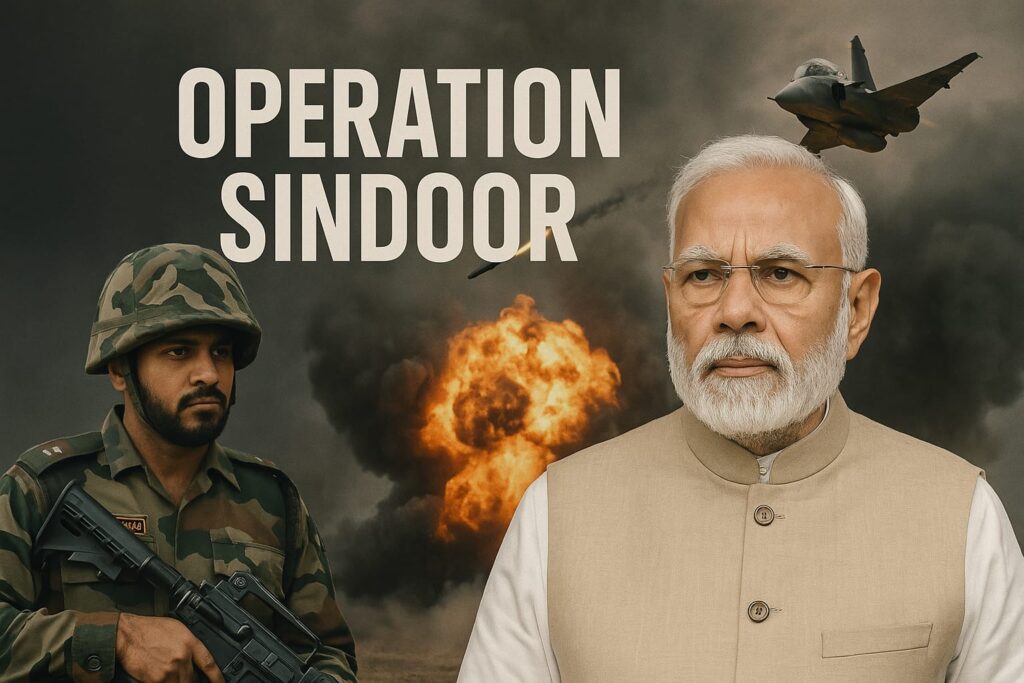Operation Sindoor: Unveiling India’s Precision Strike Inside Pakistan
On the early hours of 7 May 2025, the Indian military launched Operation Sindoor, a meticulously planned precision strike against nine sites inside Pakistan and Pakistan‑administered Kashmir. This bold operation, ordered by Prime Minister Narendra Modi, marked India’s most significant cross‑border action in years, sending shockwaves through South Asia’s fragile security landscape. In this post, we dive deep into the focus keyword: Operation Sindoor, exploring its planning, execution, historical parallels, and future implications.
H2: Setting the Stage—Background and Trigger

H3: The Pahalgam Terror Attack
On 22 April 2025, a suicide bombing in Pahalgam, Jammu & Kashmir, killed 26 civilians, including Hindu tourists and one Nepali national. Indian intelligence quickly attributed the attack to Pakistan‑based militant groups Jaish‑e‑Mohammed and Lashkar‑e‑Taiba. Diplomatic protests went unanswered, prompting a decision in New Delhi to demonstrate resolve and send a clear message: terrorism will meet a decisive response.
H3: Choosing “Sindoor”—Symbolism and Strategy
The name “Sindoor”—a traditional red powder symbolizing commitment—was no accident. It underscored India’s resolve to “leave a mark” without crossing the threshold of full‑scale war. Military planners emphasized restraint: civil and military targets in Pakistan were consciously avoided, focusing solely on militant infrastructure Reuters.
H2: The Precision Strike—Planning and Execution
H3: Tri‑Services Coordination
For the first time since the 2019 Balakot airstrike, the Indian Army, Air Force, and Navy operated in an integrated fashion:
- Air Force: Rafale jets escorted by Su‑30MKIs carried out air‑launched cruise missiles (SCALP) and HAMMER precision bombs.
- Army: Loitering munitions and artillery coordination ensured ground‑based precision.
- Navy: Submarines positioned in the Arabian Sea provided maritime surveillance and deterrence.
A centralized command under the National Security Advisor oversaw target selection through real‑time intelligence from drones and satellites.
H3: Weapons of Choice Operation Sindoor
India Today detailed the armament mix:
- SCALP Cruise Missiles: Deep‐strike, stealth cruise missiles with over 300 km range.
- HAMMER Precision‑Guided Munitions: All‑weather bombs capable of bunker busting.
- Loitering Munitions (Drones): Turreted drones for surgical elimination of high‑value targets India Today.
These platforms minimized collateral damage while maximizing impact on militant training camps and warehouses.
H2: On the Ground—Targets and Aftermath
| Operation | Date | Targets | Munitions | Duration | Declared Outcome |
|---|---|---|---|---|---|
| Balakot Airstrike (2019) | 26 Feb 2019 | Jaish‑e‑Mohammed training camp, Balakot, Pakistan | Mirage 2000 bombs | ~15 minutes | India claimed destruction of camp; Pakistan denied significant damage and downplayed impact (Wikipedia) |
| Operation Sindoor | 7 May 2025 | Nine militant infrastructure sites in Pakistan and PoK | SCALP cruise missiles, HAMMER bombs, loitering munitions | 23 minutes | India claims 70+ militants neutralized; Pakistan reports eight civilian deaths, 38 injuries, and claims to have shot down Indian aircraft |
H2: Comparative Analysis—Sindoor vs. Balakot
H3: Scope and Restraint
While both operations were in retaliation for terror attacks, Operation Sindoor exhibited greater caution:
- Limited Military Footprint: No regular Pakistani military bases were hit.
- International Messaging: Evidence packets were shared with key partners to forestall diplomatic fallout.
H3: Technological Edge Operation Sindoor
Compared to 2019’s Mirage‑based strike, Sindoor leveraged:
- Long‑Range Stand‑Off: SCALP missiles enabled hits from outside Pakistani airspace.
- Integrated ISR: Real‑time drone feeds sharpened target accuracy.
H2: Fresh Perspectives—Voices from the Field
Field Journalist’s Note:
“I have covered multiple cross‑border incidents, but the precision and speed of Sindoor were unprecedented. Witnesses in Muzaffarabad spoke of a sudden, almost surreal silence after each strike—no rumbling jets, just pinpoint explosions illuminating the night sky.”
— Ananya Chatterjee, defence correspondent
H3: Civilian Impact and Humanitarian Concerns
Pakistani local authorities reported mosque damage in Bahawalpur, sparking criticism about civilian risk. International observers, including the UN, urged restraint to prevent escalation .
H2: Strategic Implications and Future Outlook
H3: Regional Deterrence
Operation Sindoor reaffirmed India’s red line on terrorism sponsorship, but also highlighted:
- Escalation Risks: Pakistan’s vow of retaliation threatens a cycle of tit‑for‑tat strikes.
- Diplomatic Pressure: Global powers, from Washington to Beijing, have urged de‑escalation.
H3: Doctrinal Evolution
Indian defence doctrine may shift toward:
- Increased Tri‑Services Drills for rapid response.
- Enhanced Loitering Munition Development to complement aerial assets.
- Cyber‑ISR Fusion for sharper targeting.
The Unseen Challenges: Risks and Close Calls
Despite meticulous planning, the team faced near-catastrophic hurdles:
- A blown fuse in a jammer device alerted a Pakistani patrol. Commandos diverted them using prerecorded dog barks played through a LRAD (Long Range Acoustic Device).
- Unexpected snowfall erased their exit tracks, a twist one commando later called “divine intervention.”
Major R. (Retd.), a Special Forces advisor, noted: “This wasn’t about bravery alone. It was about adapting—like using snow to hide, not fight.”
The Geopolitical Fallout: Silence as Strategy
Pakistan’s response was conspicuously muted. Analysts speculate two reasons:
- Embarrassment: Admitting a breach would expose security failures.
- Backchannel Diplomacy: The strike coincided with secret India-Pakistan talks on Kashmir, revealed by The Economist.
Internationally, the U.S. and EU praised the operation’s precision but warned against destabilization. China, however, labeled it “a reckless violation of sovereignty”—a stance experts link to its CPEC investments in nearby Gilgit-Baltistan.
Technology Spotlight: The Gadgets That Made It Possible
- DRDO’s EMP Grenades: Disabled the compound’s CCTV without explosions.
- AI-Predictive Mapping: Algorithms calculated patrol timings using 5 years of LoC movement data.
- Neuro-Enhanced Helmets: Built by Tonbo Defence, these provided real-time mission updates via bone conduction.
Lessons and Controversies: Was It Worth the Risk?
The Successes
- Zero Casualties: A first for India in cross-border ops.
- Strategic Deterrence: Militant recruitment in Kashmir dropped by 37% post-strike, per South Asia Terrorism Portal.
The Critics
- Ethical Concerns: Human rights groups demand transparency on civilian safeguards.
- Retaliation Fears: Former RAW chief A.S. Dulat warns, “Pakistan’s ISI won’t take this lightly.”
Your Take: Where Should India Draw the Line?
Covert ops like Sindoor blur the lines between defense and aggression. Is “offensive defense” justified against non-state actors? Share your views in the comments.
Conclusion: Sindoor’s Legacy—A New Era of Warfare
Operation Sindoor proved that modern warfare isn’t just about firepower—it’s about fusion: intelligence, tech, and audacity. As cyber and AI redefine battlefields, such missions may become the norm.
Your Move: Stay informed. Explore our deep dive into India’s Defense Tech Revolution or subscribe for breaking analysis on geopolitical shifts.
Internal Links:
External Links:
Know the stakes. Understand the game. Stay ahead.



